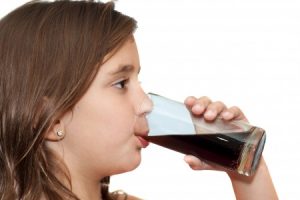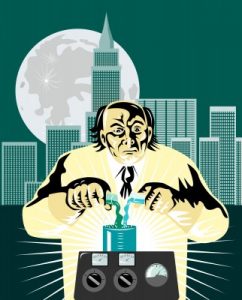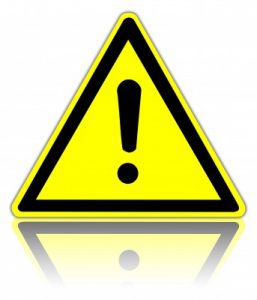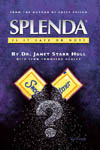
It seems that as time goes on, more confusion arises about the safety of the chlorine in Splenda®.
Why it is toxic? Why is the chlorine in Splenda different from the chloride in table salt?
I am writing this article to set the record straight about chlorine, chloride, table salt, sucralose, Splenda, and the various chlorine compounds out there.
Chemistry Anyone?

If you’re not a chemist, I will make this Splenda chemistry lesson as enjoyable as I can.
All chemists are different – they apply chemistry differently. I am a geologist, so I apply chemistry to the many compounds that exist in nature, particularly those in rocks and minerals.
A biological chemist sees the world through the chemical combinations of elements that come to life inside a living organism, and those combinations change, morph, and evolve in many different ways. Hence, the Circle of Life.
A NASA chemist uses his chemistry skills in environments unlike the Earth’s – so chemistry means really different things to an astrophysicist.
My point is to defend the reality that not everyone will interpret chlorine and chlorides exactly the same. To me, I apply the chemistry to the chlorine in Splenda as a new, man-made compound created for the sole purpose of marketing a sugar-free product that doesn’t exist in Nature.
This isn’t necessarily a bad thing when it comes to building materials or eye-glasses, but I personally don’t want to eat or drink things created in a laboratory because they are not natural and they’re going into my body.
No other animals eat or drink the sucralose in Splenda.
Trying To Make It Work
Typically when you combine chlorine with another element, you create a chloride. But in my opinion, the safety of the chlorine in Splenda is a fantasy that people are trying to make work.
The chlorine in Splenda is NOT healthy – it exists artificially because it is “forced technology.” Sucralose found in Splenda is not real, especially to your body. It is not a natural compounded chloride – like what we see in Nature, and it wouldn’t exist if it weren’t a chemical concoction out of a lab beaker.
Sucralose/Splenda is not natural in any way. I recommend never eating or drinking any form of chlorine because chlorine has been proven to cause cancer.
Consuming Splenda is no safer than consuming chlorinated tap water, pool water, or aquarium water.

Chlorine Is Poisonous
There are 3 atoms of chlorine injected into a sugar molecule in order to make Splenda. However, in Splenda, the chlorine and sucrose (sugar) do not combine to make a chloride – they just don’t.
The chlorine in Splenda remains chlorine; uncombined, gaseous chlorine. So, what you get is chlorinated sugar, and this is not good.
Chlorine isn’t a bad thing if you don’t eat it. It is a natural element on our Periodic Table of Elements, but chlorine is not meant to be consumed as an isolated element – it is poisonous.
Chlorides, such as potassium chloride, calcium chloride or sodium chloride (table salt), on the other hand, are safe to consume. It’s the isolated chlorine atoms that are not meant to be eaten.
Just because an element is on the Periodic Table, doesn’t mean it is safe to consume. For example, we don’t eat krypton, lead, or radon, which are all elements on the Periodic Table. And again, in the Splenda molecule called sucralose, chlorine does not combine with sucrose to form sucrose chloride. Nope.
The chlorine remains chlorine, and is released as gaseous chlorine when broken down.
So, my main point here is that sucrose (sugar) and chlorine never do combine in Splenda. There is NOT a “sucrose chloride” compound found anywhere outside the laboratory.
Sucralose is a toxic, man-made concoction where chlorine remains chlorine, and this is making people sick.
On pages 14-15 in my book on Splenda, I published the chemical formula for sucralose (Splenda). The manufacturers used chemicals such as benzene, toluene, lithium chloride (a chlorine compound), and a list of other nasty chemicals to “insert” the chlorine into the sugar molecule replacing the 3 atoms of sugar, and significantly reducing the calories.
Stay Cautious
As I write in Splenda: Is It Safe Or Not?, chlorine hasn’t changed – man’s use of it has.
I never dreamed that chlorine would be used to the point that it is today. And I never dreamed that it would be dropped into our food supply to the degree it has been. Most of us have grown up with various chlorine products, like in our swimming pool, and the sodium chloride found in table salt.
But don’t confuse the natural forms of chlorine/chloride with the manufactured forms, and do not assume the chlorine in Splenda is safe like salt.
Organochlorine

Sucralose is an organochlorine, which is a combination of chlorine and organic substances. Pesticides, plastics, paints, dyes, medications, deodorants, bleaching agents, refrigerants, wood preservatives, and cleaning solvents, just to list a few, are common examples of organochlorines.
So, chemically, Splenda is not a lot of things:
- it is not a natural form of chlorine;
- it is not a chloride compound;
- it is not natural in any way.
It is an organochlorine and a chlorocarbon – both carcinogenic chlorine compounds.
For now, just put away your Splenda.

_____________
Join my Private Membership Program
Gain access to all of my online programs, ongoing support, monthly Q&A, and more by joining my Private Inner Circle Membership Program. I look forward to supporting you on your journey to alternative health and wellness.
_____________
Disclaimer: This article is for informational purposes only, and is educational in nature. The FDA may not have evaluated some of the statements. This article is not intended to diagnose, treat, cure, or prevent any disease. Please discuss with your own, qualified health care provider before adding supplements or making any changes to your dietary program.
Before taking vitamins, consult your doctor; pre-existing medical conditions or medications you are taking can affect how your body responds to multivitamins.